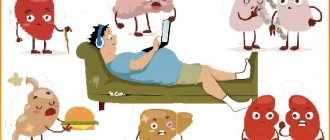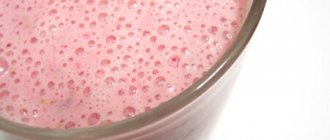What is metabolism
Metabolism is the chemical process of converting nutritional components that enter the body along with food. In other words, the body breaks down food into small particles and creates molecules from them. The functioning of all organs is impossible without the presence of such energy.
There are two main types of metabolism:
- Anabolism is a complex of chemical processes through which new tissues and cells are formed in the body.
- Catabolism is a set of processes that destroy complex elements into simple ones.
Metabolic rate
Metabolic rate is the amount of energy required by the body to carry out full activities.
This indicator comes in several types:
- The minimum speed, which is present only at moments when the body is at rest.
- The person is at rest, but does not sleep, but also does not overload himself with excessive loads. This type processes approximately fifty to seventy percent of the calories that are consumed and burned by the body daily.
- The thermic effect of food refers to the calories that the body needs to digest food.
- The thermic effect of sports activity is those calories that are broken down during exercise.
- There is another thermogenesis, during which resources are spent on moderate physical activity.
How many calories do you need to take in daily?
The first step in calculating the number of calories is calculating the BMR using any of the three methods presented. The second step is to multiply the final BMR number by the physical activity coefficient , which has 5 types:
- passive type - if you have minimal or no physical activity, multiply your BMR by a factor of 1.2.
- minimally active type - if you train 1-3 times a week, multiply your BMR by a factor of 1.375.
- moderately active type - if you train 3-5 times a week, multiply your BMR by a factor of 1.55.
- active type - if you train 5-6 times a week, multiply your BMR by a factor of 1.725.
- overly active type - if you are a professional athlete or train 6-7 times a week or have a physically demanding job, multiply your BMR by a factor of 1.9. [2]
The resulting number represents your energy requirement, and the number of calories you need each day to maintain your weight. If you want to lose weight , you need to take in fewer calories and vice versa, if you want to gain weight , you need to take in more calories . [2]
Factors affecting metabolism
Diet
Metabolism is mainly affected by:
- Age. The best metabolic rates are present in the human body at the age of twenty. After this age, they deteriorate by two to three percent every decade.
- Hormonal background. All processes that occur inside the body directly depend on its condition. Thus, if a person suffers from disruptions in the functioning of the hormonal system, this can negatively affect the rate of absorption of substances.
- Diet. If a person consumes excessive amounts of fatty, fried, smoked and other unhealthy foods, this negatively affects the quality of digestion. In addition, regular diets and hunger have a similar effect on these processes.
- Water mode. Without fluid, none of the processes occurring inside the body is possible. With excessive or insufficient water intake, the body is not able to fully function. It is recommended to drink two to two and a half liters of fluid per day.
- Lifestyle. The rate of food absorption is directly affected by the amount of physical activity: the more of it, the better the food is digested.
Read
About the functions of the gallbladder in the human body
Genetic predisposition plays an important role. However, if metabolism is slowed down solely due to heredity, then it will not be possible to correct it.
Metabolism tests
Many people who are beginning to care about their health are completely unaware of what tests to take to check their metabolism
. There are two main options here:
- Donate blood to determine metabolic rate.
- Take a genetic test.
In the first case, blood is taken from the patient on an empty stomach to obtain a more accurate result. At the same time, in a biochemical laboratory, a blood test for metabolism
is carried out according to a whole range of parameters that are compared with the normal state of the body. Thus, the blood sugar level is determined (the normal glucose level is 70-100 mg/dL), insulin level (the normal level is 6-25 mg/ml), hemoglobin, cholesterol, insulin response to glucose, the level of electrolytes and minerals in the blood, etc. Deviation from the norm by one or another indicator can already indicate serious disorders in the body.
Genetic studies of metabolism or DNA test for metabolism in St. Petersburg
carried out in special laboratories. Using this test, you can identify not only a person’s predisposition to certain diseases, but also accurately determine his metabolism at the gene level. Most often, this research method is used to establish an accurate picture of the patient’s health status.
Symptoms of impaired metabolism
Bloating
The following signs may indicate metabolic problems:
- excess weight, which you cannot get rid of either through diets, physical exercise, or other similar methods;
- constant feeling of fatigue;
- low body temperature;
- flatulence;
- bloating;
- allergic reactions;
- acquired intolerance to certain foods;
- insomnia or disruptions in sleep patterns;
- feeling of anxiety;
- lethargy;
- regular colds;
- constipation;
- reduced concentration level;
- diarrhea;
- dizziness;
- heartburn;
- increased irritability;
- nails become brittle and stop growing.
Signs of a healthy metabolism
If a person has no problems with uncontrolled gain or loss of kilograms of weight, it means that the body absorbs the incoming substances well.
A good exchange can be called one that digests food neither in an accelerated nor in a slow manner.
The fact that the metabolic level is within optimal limits is indicated by:
- stable functioning of the gastrointestinal tract;
- there are no rashes on the face;
- hair is in good condition;
- Feeling tired is rare.
How to change a slow metabolism
In order to speed up a slow metabolism, it is necessary to review your diet. It is worth including products that contain fiber (porridge, hard pasta) and proteins (fermented milk, dairy products, chicken, eggs). Eating citrus fruits of any kind will be beneficial: lemons, oranges, tangerines, grapefruits, etc.
Fractional meals
It is better to eat according to the fractional system. That is, eat food five to six times a day, but in reduced portions. It is recommended to eat at approximately the same time, since over time the body gets used to the regime and begins to better absorb food at a certain time of the day.
It is necessary to drink enough water. You need to take at least two, but no more than three liters per day. You can dilute the intake of liquids with the help of compotes, decoctions based on medicinal plants, freshly prepared juices, green tea, and fruit drinks. It is not advisable to add sugar to drinks, but the use of sweetener substitutes is acceptable.
Read
About the normal level of sugar and cholesterol in the blood
It is necessary to devote sufficient time to sleep and rest. At night, a person should sleep at least seven to eight hours. It is useful to regularly be in the fresh air, taking leisurely walks. Physical activity is a prerequisite, without which it is unlikely that you will be able to speed up your metabolism. However, it is not worth tormenting the body with excessive stress. An organism exhausted by sports will begin to consume energy from its own resources, which not only will not help speed up metabolism, but will also slow it down even more.
It is necessary to build and stick to a daily routine. It is recommended to go to bed no later than ten in the evening, and wake up around eight or nine in the morning. It is advisable to have dinner three to four hours before going to bed. You will have to give up late-night snacks.
Quitting alcohol
It is recommended to refrain from drinking alcoholic and low-alcohol drinks. Smoking has a detrimental effect on metabolism, so you should give up cigarettes. However, if quitting smoking right away is too difficult, you are allowed to smoke no more than two or three pieces a day.
If a person wants to speed up metabolism with the help of special drugs, it is necessary to consult a relevant doctor. Self-medication can lead to deterioration of health and the development of some side effects.
What is basal metabolism?
Such physiological processes support the vital functions of the body.
A significant portion of the energy released as a result of metabolic reactions of the basal type is spent on:
- heartbeat;
- respiratory activity;
- functioning of the endocrine glands;
- thermoregulation;
- digestion;
- work of the hepatobiliary mechanism;
- renal activity.
Basal metabolism is the main material metabolism determined during the period of wakefulness, with muscular and emotional rest, a comfortable ambient temperature within the range of +18...+22°C.
The transformation of endogenous compounds and nutrients is a constantly occurring biochemical change in a living organism, affecting tissue structures, cells, and biological fluids.
The key goal of basal metabolism is to process food into the energy necessary to maintain life.
During basal metabolism:
- protein and other proteins are synthesized;
- fats are broken down;
- carbohydrates are released;
- some amino acids are produced;
- Nitrogen waste, which is a by-product of such physiological reactions, is removed.
Basal type metabolism can be primary or secondary. Each has its own complex purpose. Primary metabolic reactions are aimed at carrying out basic biochemical reactions.
They determine the development, vital activity and growth of the body.
Basal Metabolism
As a result of such processes, the following are produced:
- saccharides are the main source of energy;
- lipid substances that form the basis of subcutaneous tissue, the protective capsule of some vital internal organs;
- amino acids;
- nucleic substances that store, transmit and implement genetic information.
Secondary basal metabolism - biochemical reactions in individual structural groups.
They are aimed at the production and breakdown of specific substances of non-protein nature:
- immunocompetent compounds;
- hormones;
- pigments;
- building molecules that form the skeletal frame, hair, nail plates.
The rate at which food is converted into energy is called the metabolic rate. This indicator is individual. It depends on the functioning of the nervous system and the endocrine mechanism, the current state of the internal organs.
How to calculate metabolic rate for men
Let's consider how to determine the metabolism of men. The procedure consists of several stages:
- Set height in centimeters. Basal metabolic rate (BMR) depends on height: the taller the person, the faster the metabolism.
- Set body weight in kilograms. The amount of energy consumed directly depends on a person’s weight. That is, the larger the person, the more energy the body needs to carry out full-fledged activities.
There is a special equation for installation. Its formula is: basal metabolic rate = 66 + (13.8 times weight in kilograms) + (5 times height in centimeters) - (6.8 times age).
Basal Metabolism Formula
Factors that influence UBM
Several factors influence UBM:
- weight – people with high weight will receive a higher BMR number
- body type – adipose tissue is known to have lower metabolic activity than muscle tissue. As muscle mass increases, your metabolic rate also increases.
- gender - basal metabolism in men is approximately 5 - 10% higher than in women. The reason for this is that women have more body fat than men of the same weight and height.
- age – metabolic rate decreases with age, the reason for this is the loss of muscle tissue, the growth of fatty tissue, as well as hormonal and neurological changes.
- body temperature – for every increase in body temperature by 0.5°C, BMR increases by 7%. Chemical reactions in the body occur faster at high temperatures.
- health status – illness or injury can double your metabolic rate because the body needs more energy to recover. [4] [7]
Your BMR is also affected by your macronutrient :
- fats increase BMR by 5%
- carbohydrates increase BMR by 5 – 10%
- proteins increase BMR by 20–30% [8]
Determination of female metabolism
Almost all women watch their figure. That is why they often ask the question: what kind of metabolism do I have? You can find out by analogy with the male method.
Read
How to clean tartar at home
First you need to set your height in centimeters and weight in kilograms. Female version of the equation: BSM = 655 + (9.6 times body weight in kilograms) + (1.8 times height in centimeters) - (4.7 times age). In both cases, speed is measured in one unit - kilocalories.
How to measure BMR?
Minimal neural activity is required to obtain a reliable and objective laboratory value. The subject is immersed in a state of complete rest. For the calculation, a specially developed Harris-Benedict, Mifflin-San Jeor or Kutch-McArdle formula is used.
The first one was developed in 1984 by an American physiologist and nutritionist, after whom it is named. In 1990, a more accurate and up-to-date formula for calculating basal metabolic rate was introduced. Its authorship belongs to a group of American nutritionists, led by Doctors Mifflin and Saint-Jeor. This formula is considered the most accurate.
The Kacha-McArdle scheme appeared relatively recently. Its difference from other used formulas lies in the possibility of calculating the body’s energy expenditure during sleep. It takes into account the volume of muscle mass and the activity of muscle structures in an unconscious state. The technique is suitable for professional athletes. Basal metabolism slows with age and as lean body mass decreases.
Strength and aerobic exercises significantly increase the body's energy consumption. The Kutch-McArdle formula allows you to accurately calculate this indicator. Graphically it is written as follows: BMR=370+21.6 (1-F) x W.
The letter F means the percentage of body fat from the total body weight, W – weight in kg. The updated Harris-Benedict equation for calculating basal metabolic rate in men is as follows: BMR=13.397xW+4.799xH-5.667xA+88.362.
The letter H is height in cm, A is age. The formula for women differs in the coefficients entered, but not in the calculation principle. It looks like this: BMR=9.247xW+3.098xH-4.330xA+447.593.
Basal metabolic rate can be calculated using the Mifflin-St. Jeor formula. This equation is used to determine daily calorie needs. The formula for men is as follows: BMR=10xW+6.25xH-5xA+5. The equation for women differs only in the last numerical factor. It has a value of -161.










